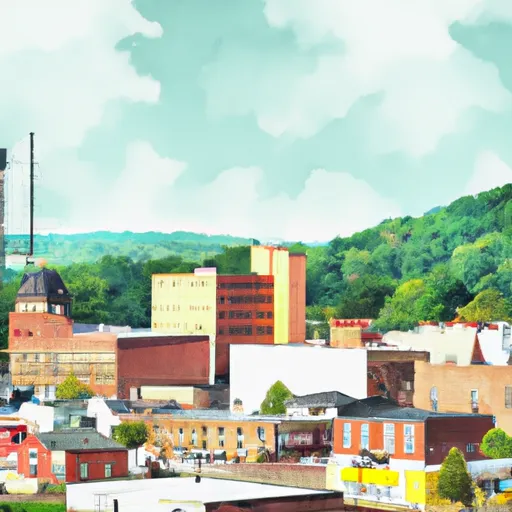-
 Snoflo Premium
Snoflo Premium
Get unlimited access to all our content
With no Ad interruptions! - Start Your Free Trial Login with existing account
Troutville
Eden Index
Climate
8.7
•
Recreation
2.8
•
Community
•
Safeguard
4.4/10

Troutville is a small charming borough nestled in Clearfield County, Pennsylvania. The region experiences a humid continental climate, characterized by warm summers and cold winters. Average temperatures range from the mid-80s Fahrenheit (27-30°C) during summer to the mid-20s Fahrenheit (-3 to -6°C) in winter. The area receives a moderate amount of rainfall throughout the year, with slightly more precipitation occurring during the summer months.
Troutville benefits from its proximity to numerous water bodies, making it an excellent destination for hydrology enthusiasts. The borough is surrounded by scenic rivers and streams, providing ample opportunities for fishing, canoeing, and kayaking. The nearby West Branch Susquehanna River is particularly popular for trout fishing, attracting anglers from all over.
Outdoor enthusiasts will find plenty of recreational activities in Troutville. The picturesque surrounding forests offer hiking and biking trails, perfect for exploring the area's natural beauty. Additionally, the borough is home to several parks and campgrounds, providing opportunities for picnicking, camping, and wildlife observation.
Overall, Troutville offers a tranquil and idyllic setting for those seeking outdoor adventures and a serene escape in the heart of Pennsylvania.
What is the Eden Index?
The Snoflo Eden Index serves as a comprehensive rating system for regions, evaluating their desirability through a holistic assessment of climate health, outdoor recreation opportunities, and natural disaster risk, acknowledging the profound impact of these factors on livability and well-being.
Climate Health Indicator (CHI): 8.7
Troutville receives approximately
1131mm of rain per year,
with humidity levels near 79%
and air temperatures averaging around
9°C.
Troutville has a plant hardyness factor of
5, meaning
plants and agriculture in this region thrive during a short period during spring and early summer. Most
plants will die off during the colder winter months.
By considering the ideal temperature range, reliable water supplies, clean air, and stable seasonal rain or snowpacks, the Climate Health Indicator (CHI) underscores the significance of a healthy climate as the foundation for quality living.
A healthy climate is paramount for ensuring a high quality of life and livability in a region, fostering both physical well-being and environmental harmony. This can be characterized by ideal temperatures, reliable access to water supplies, clean air, and consistent seasonal rain or snowpacks.
Weather Forecast
Streamflow Conditions
Allegheny
Area Rivers
Allegheny
Snowpack Depths
Allegheny
Reservoir Storage Capacity
Allegheny
Groundwater Levels
Recreational Opportunity Index (ROI): 2.8
The Recreational Opportunity Index (ROI) recognizes the value of outdoor recreational options, such as parks, hiking trails, camping sites, and fishing spots, while acknowledging that climate plays a pivotal role in ensuring the comfort and consistency of these experiences.
Access to outdoor recreational opportunities, encompassing activities such as parks, hiking, camping, and fishing, is crucial for overall well-being, and the climate plays a pivotal role in enabling and enhancing these experiences, ensuring that individuals can engage in nature-based activities comfortably and consistently.
Camping Areas
| Campground | Campsites | Reservations | Toilets | Showers | Elevation |
|---|---|---|---|---|---|
| Red Mill | 10 | 1,524 ft | |||
| East Branch Lake | None | 1,732 ft | |||
| Blue Knob State Park | None | 2,576 ft | |||
| Lorain Borough Park | None | 1,316 ft | |||
| Twin Lakes Rec Area | 211 | 1,760 ft | |||
| Quemahoning Family Rec Area | 63 | 1,668 ft | |||
| Nanty Glo Municipal Park | None | 1,733 ft | |||
| Duman Lake County Park | 6 | 1,743 ft | |||
| Adams Croyle | None | 1,688 ft | |||
| Shawnee State Park | None | 1,254 ft |
Nearby Ski Areas
Catastrophe Safeguard Index (CSI):
The Catastrophe Safeguard Index (CSI) recognizes that natural disaster risk, encompassing floods, fires, hurricanes, and tornadoes, can drastically affect safety and the overall appeal of an area.
The level of natural disaster risk in a region significantly affects safety and the overall livability, with climate change amplifying these risks by potentially increasing the frequency and intensity of events like floods, fires, hurricanes, and tornadoes, thereby posing substantial challenges to community resilience and well-being.
Community Resilience Indicator (CRI):
The Community Resilience Indicator (CRI) recognizes that education, healthcare, and socioeconomics are crucial to the well-being of a region. The CRI acknowledges the profound impact of these elements on residents' overall quality of life. By evaluating educational resources, healthcare accessibility, and economic inclusivity, the index captures the essential aspects that contribute to a thriving community, fostering resident satisfaction, equity, and social cohesion.

